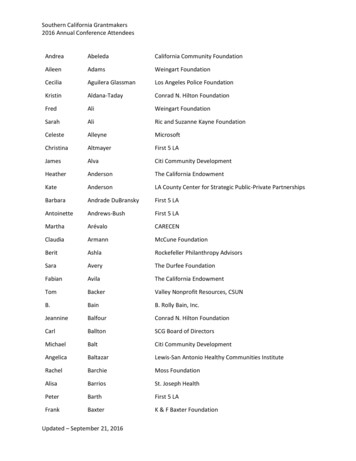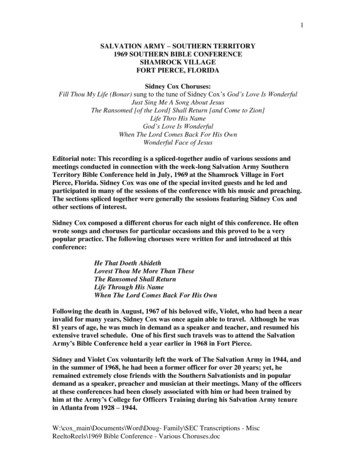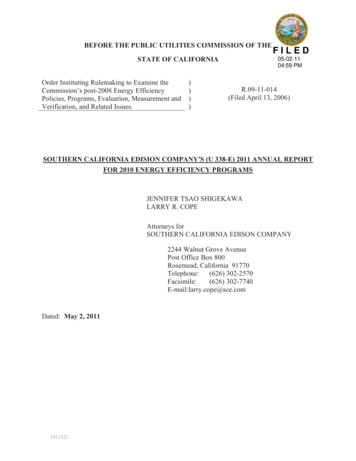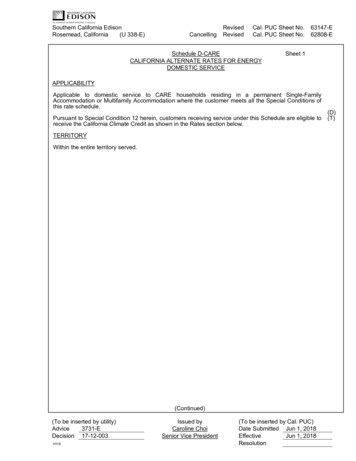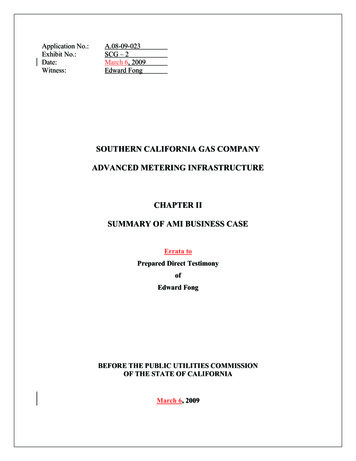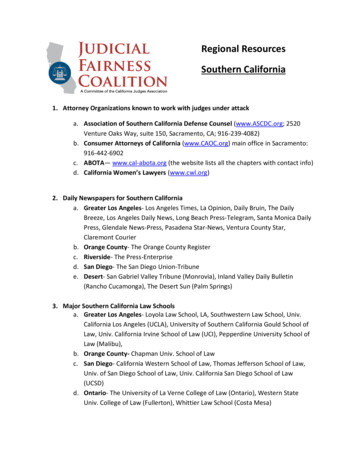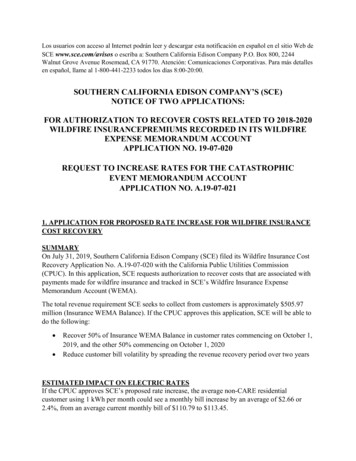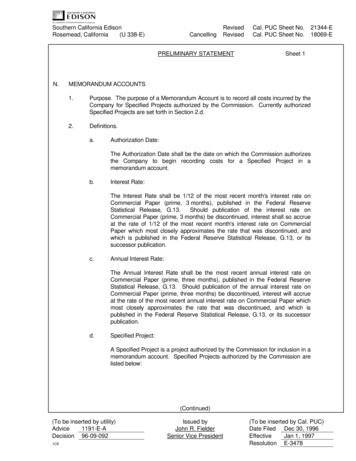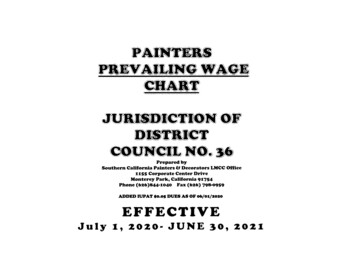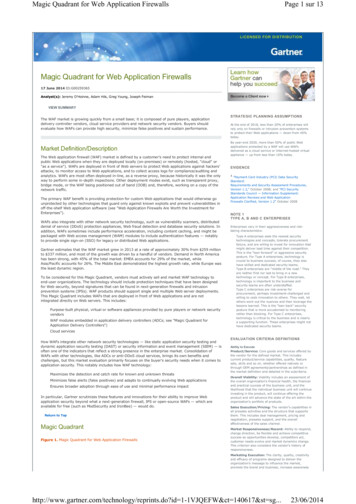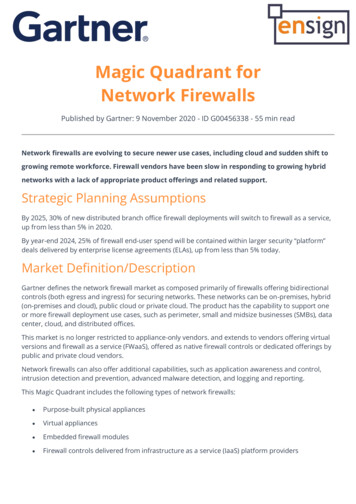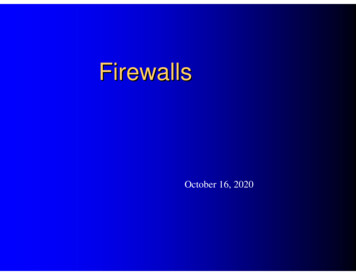
Transcription
FirewallsOctober 16, 2020
Administrative – submittal instructions answer the lab assignment’s questions in written reportform, as a text, pdf, or Word document file (no obscureformats please)deadline is start of your lab session the following weekreports not accepted (zero for lab) if latesubmit via D2L
Administrative – script files reminder re-download the script files' zipto obtain the new vmconfigure scripts for this "sniffing" exercise
Firewall types Packet filter––––– linux, netfilter-basedBSD, PF subsystemWindows’s built-in (since XP)router device built-inssingle TCP conversationProxy server– specialized server program on internal machine– client talks to it instead of desired external server– it conducts conversation with external server for client andplays relay middleman between them subject to policy– 2 separate TCP conversations
Linux “Netfilter” projectNetfilter produced iptables, now nftables centerpiece commands: iptables, nft – nft replaces/extends legacy iptables– both coexist in recent linux distributionspacket filter, not proxy starting point: packet structure details
IP packet structureSource AddressDestination AddressIP’s Data PayloadProtocolNumber
Payload types - subprotocolsSrcDest17SrcDestUDP (17) datagramICMP (1) messageSrcDest6TCP (6) packet and others1
UDP datagram structureSource PortDestination PortUDP’s Data Payload
TCP packet structureSource PortDestination PortSequence #AcknowledgmentTCP’s Data Payload
ICMP message structureICMP-typeCodeChecksumheader of subject/wayward IP packetor otherICMP-type dependent payload
Firewall rulesetan in-memory datastructure by whose elementspackets that appear at interfaces are evaluated a corresponding series of commands, eachinvocation of which populates the table with asingle element elements are called “rules”
Firewall - nftables nft command – single invocation creates single rule firewall is product of multiple invocations
nftables organization tables contain chains– chains have typesfilter type chains nat type chains – user creates all chains, none exist by default chains contain rules– chain types have "hooks" filter type– input hook– output– forwardsample chain creation syntax: nat type– prerouting hook– postroutingnft 'add chain ip mytable myinputchain { type filter hook inputpriority 1; policy accept; }'
An Individual Rulecondition - examines and qualifies a packet action - operates on the packet if itqualifies compare – programming language “if”structure
What a Rule says“If a packet’s header looks like this, thenhere’s what to do with the packet” “looks like this” e.g. – goes to a certain (range of) address(es) or– uses the telnet port, 23 or– is an ICMP packet “what to do” e.g.– pass it– discard it
nft add rule mytable myoutputchain oifname enp0s3 tcp sport 23 tcp dport1024-65535 ip saddr 192.168.4.0/24 ip daddr 0.0.0.0/0 accept––––actionobjecttarget tabletarget chain– packet qualifiers by interface and directionprotocolsource port number(s)destination port number(s)source address (range)destination address (range)– packet disposition acceptdrop
What a Chain is ordered checklist of regulatory rules– multiple rules, for packets with particular characteristics– single rule-like default (catch-all) policy operation– packet tested against rules in succession first matching rule determines “what to do” to packet– if packet matches no rule chain’s default policy determines “what to do” to packet
Operationally comparableif [ condition A ]action Alpha; exitendifWhat happens?if [condition B ]action Beta; exitendifif [condition C ]action Gamma; exitendif.action default ; exitaction for first true condition(if any)otherwisedefault action
Multiple, typical chains input-filter chain– when arriving at an interface, do we let apacket come in? output-filter chain– when departing from an interface, do we let apacket go out? forwarding-filter chain– when traversing this machine to another, dowe let a packet pass between interfaces?
Filter traversal by OUTPUTlocal processlocal process
A 2-chain, 2-rule filtering firewallbut accept incoming to port 23and outgoing from port 23create 2 chains, for input andoutput, with default "drop"on telnet server 192.168.4.1nft 'add chain ip mytable myinputchain { type filter hook inputpriority 1; policy drop; }'nft 'add chain ip mytable myoutputchain { type filter hook output priority 1; policy drop; }'nft add rule mytable myinputchain iifname enp0s3 tcp sport 1024-65535 tcpdport 23 ip saddr 0.0.0.0/0 ip daddr 192.168.4.1/32 acceptnft add rule mytable myoutputchain oifname enp0s3 tcp sport 23 tcp dport 102465535 ip saddr 192.168.4.1 ip daddr 0.0.0.0/0 acceptExecuted in chronological sequence as shown, resultant 2-rule firewall permits telnet request intothis machine 192.168.4.1 from others via enp0s3, and reply from it out to them. And nothing else.(0.0.0.0/0 matches any address; aa.bb.cc.dd/32, the single address aa.bb.cc.dd)
address translations: rules that alter packetgiven (table and chains):nft add table mynatnft 'add chain mynat mypostrouting { type nat hook postrouting priority 100 ; }'nft 'add chain mynat myprerouting { type nat hook prerouting priority -100; }'NAT (source network address translation)nft add rule mynat mypostroutingip saddr 192.168.4.0/24 oif enp0s10snat 10.0.0.195Port forwarding (destination network address translation)nft add rule mynat mypreroutingiif enp0s10 tcp dport 23dnat 192.168.4.1
Parallel waysto do the same thing (port forward)nft add rule mynat mypreroutingtcp dport 5631 iifname eth1 ip daddr 216.83.185.193dnat to 192.168.1.15:22presupposes chain "myprerouting" in table "mynat"
Firewall ruleset philosophies optimistic/lax “that which is not expressly prohibited is permitted”– set everything open– apply selective closures pessimistic/strict “that which is not expressly permitted is prohibited”– set everything closed– apply selective openings
Setting “everything closed” policya table with 3 chains(as yet rule-less)no frames will pass(requires alleviating rules for that)
Looking further conventional filter criteria limited to header fields onlytwo further kinds of possible criteria– SPI “stateful packet inspection”– DPI “deep packet inspection”SPI – interrelates packets– can tie an incoming packet to an earlier outgoing request, accept forthat reason DPI – penetrates and examines payload (higher prototcoldata)– can see use of port 80 for non-HTTP traffic, drop for that reason– can see use of e.g. peer-to-peer file sharing, drop for that reason– tends to overlap with function of intrusion detection software
Firewall persistencefirewall is in-kernel memory-resident volatile across reboot save, then reconstruct at boot time for persistence nft list ruleset myrulesetnft -f myrulesetSornft list ruleset /etc/sysconfig/nftables.confsystemctl enable nftables.service
Avoid a vulnerability intervalfirst, call script to erect firewall only then, call script to activate/address NICs calling order can be controlled throughsystemd by its After/Before dependencysystem for ordering startup units
Other packet filter firewalls sameall are software all construct a reference data structure all compare packets to structure for decisions interfaces differ
Windows XP built-inan INPUT firewall that’spessimistic with exceptionsequivalent to"policy drop" in nft chain creationwith additional "accept" rules inthe chain, for point permission
Netgear WGR614 router built-in1. Is a computer*2. Plugs in to two LANsNetwork A / internalNetwork B / external* a router is a computer.It contains a CPU, operatingsystem, memory. It runssoftware (e.g. firewall!!) Thisone has 2 NIC interfaces. Don’tbe deceived by the lack ofkeyboard and monitor.option to pass through A-to-B & B-to-AFIREWALL HERE
Netgear WGR614 router built-inan in-to-out FORWARD firewall that’s optimistic with exceptionsequivalent to"policy accept" in chain creationwith additional "drop" rules in the chain,for point obstruction
Filter traversal by OUTPUTlocal processlocal processin the router appliance, firewall is herein the Windows machine, firewall is here
What do these 2 firewalls protect? Windows– the very machine itself that’s running Windows Netgear router– not the router itself– machines networked to the router raises concept of firewall architecture– what wiring connection “geometry” do you adopt?– on which of the computers do you run a firewall?– to protect which computers?
Architectures – screened subnet
Architectures – merged routers
Netgear WGR614 routerthe router is not the firewallthis is (the interface to) the firewall
Why do they call it a hardware firewall?it’s a firewall it’s inside a box the box is hard
Hardware 5.htm
But in computer science Firewalls are software!get it? it’s not so hard.
Please see http://www.netfilter.org/Linux Firewalls, Michael Rash, No Starch Press, 2007The Book of PF, Peter Nahsteen, No Starch Press, 2008(PF is an alternative, non-iptables firewall interface tool found in BSD)Older favorites I learned from, still useful:Linux Firewalls, 2nd edition, Robert Zeigler, New Riders, 2002Building Internet Firewalls, Zwicky et.al., O’Reilly, 2000
Linux Firewalls , Michael Rash, No Starch Press, 2007 The Book of PF , Peter Nahsteen, No Starch Press, 2008 (PF is an alternative, non-iptables firewall interface tool found in BSD) Older favorites I learned from, still useful: Linux Firewalls , 2 nd edition, Robert Zeigler, New Riders, 2002 Building
